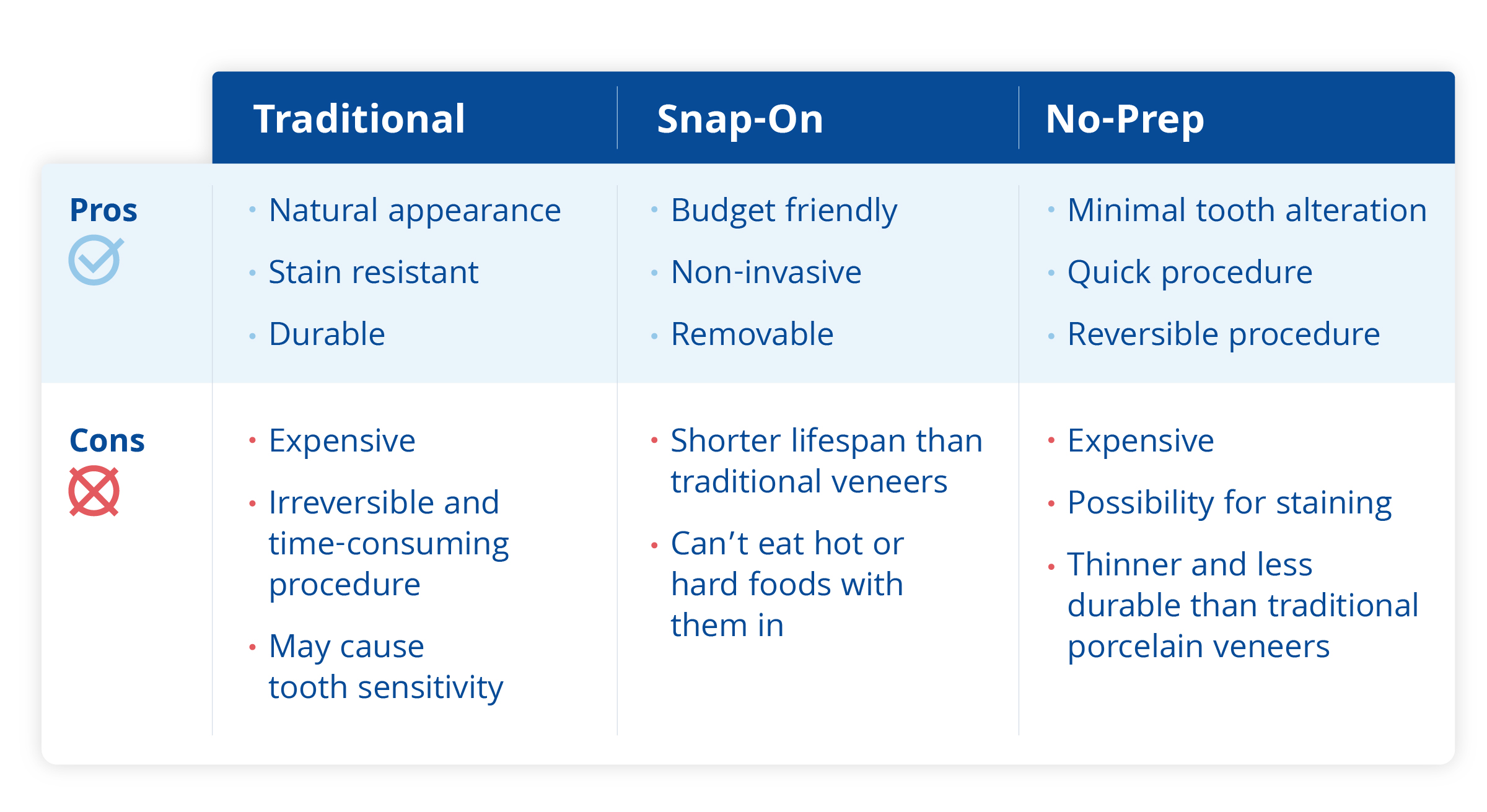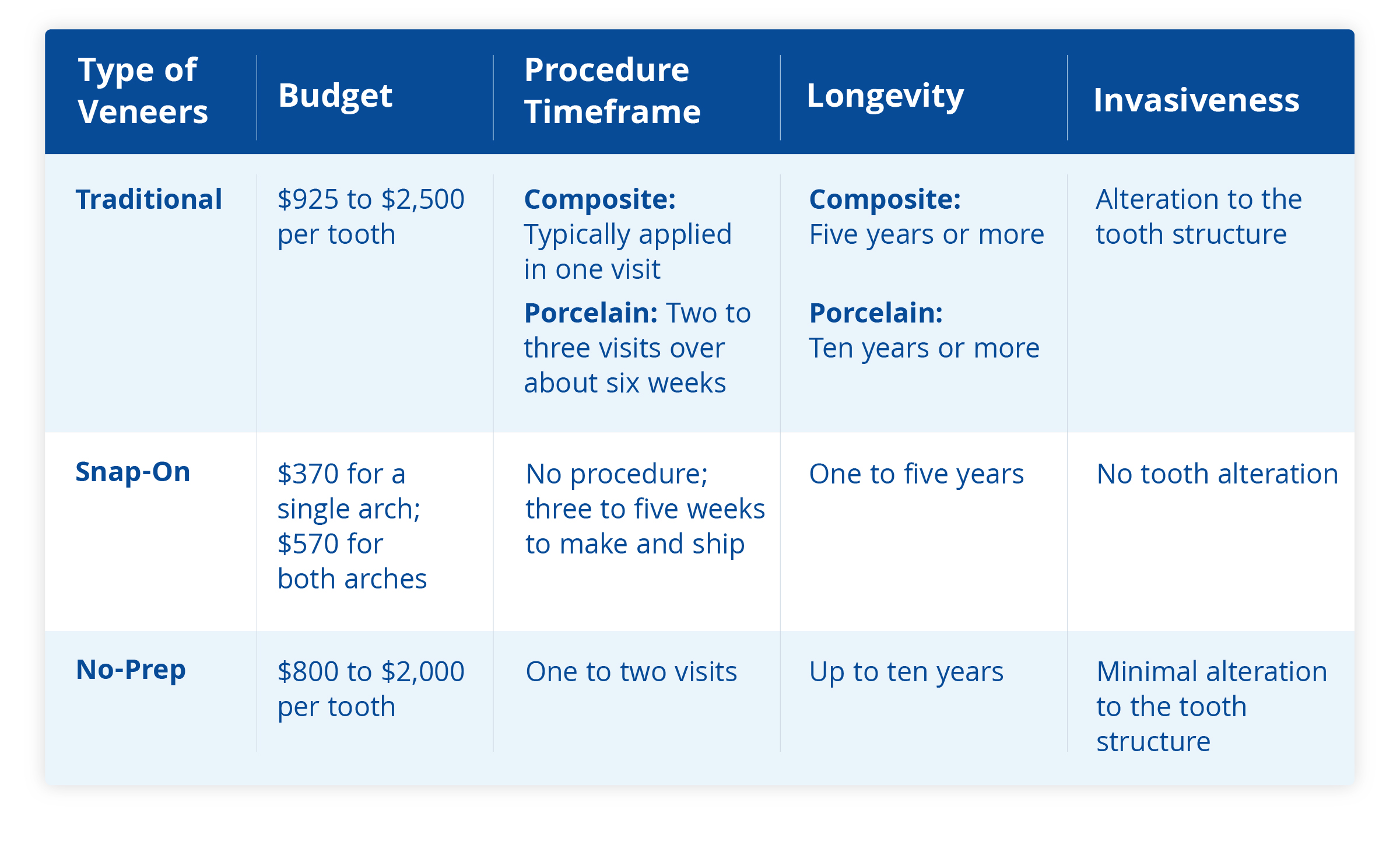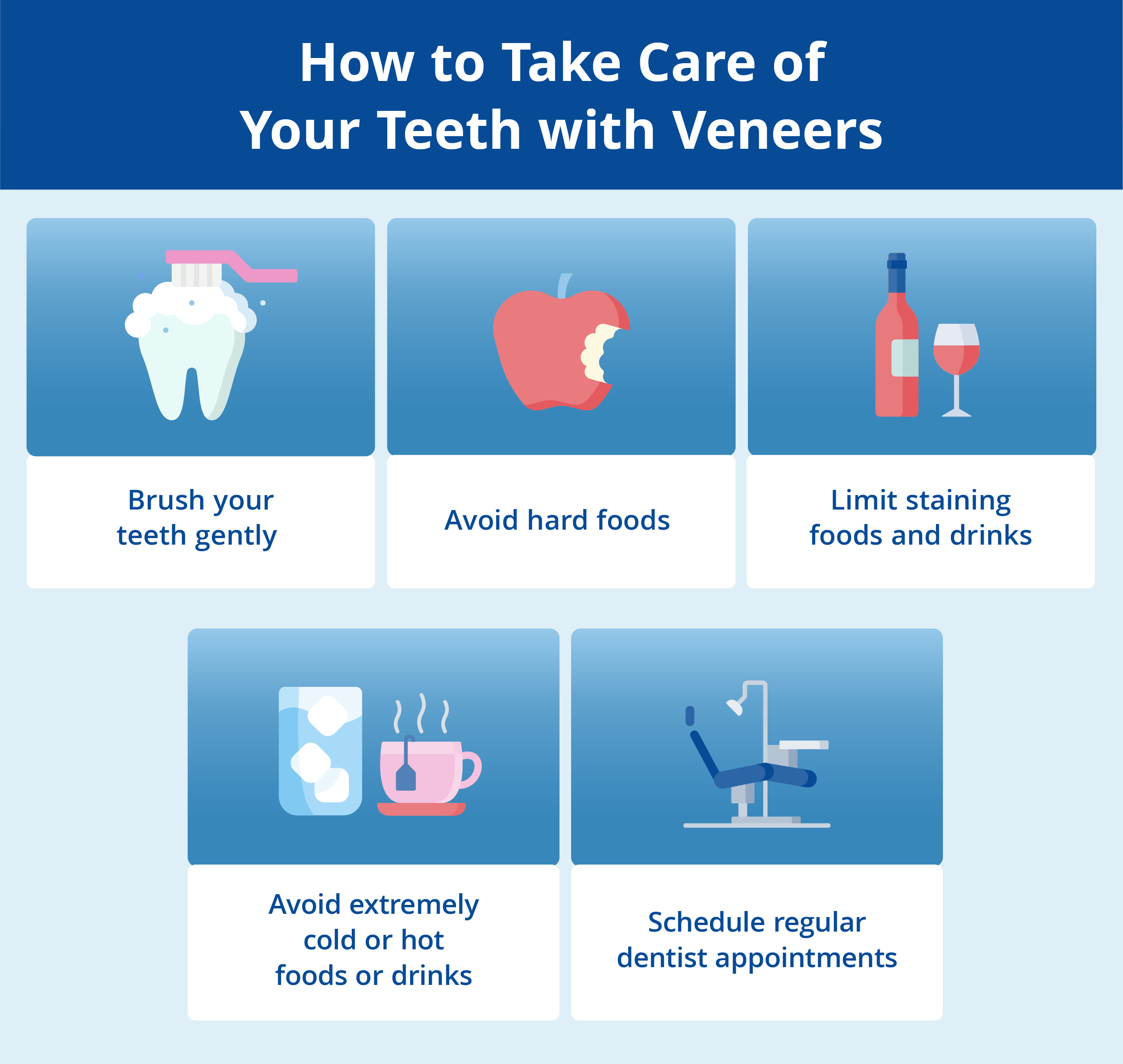

If you’re dealing with cracked, chipped, crooked, or stained teeth, or gaps in your teeth, dental veneers might be the right choice for you. Veneers are a cosmetic dental procedure that covers up aesthetic dental issues your natural teeth might have. With the proper care, a set of veneers can be a long-lasting solution, helping you get the beautiful smile you deserve.
There are three main types of veneers to choose from: traditional, snap-on, and no-prep. Each comes with its own pros and cons. For example, while they tend to be the sturdiest, traditional veneers are permanent, so make sure you consult with your dentist and even ask for pictures of past patients’ results to see if you like the look of them.
In this post, we go over the pros and cons of veneers, so you can decide which option might be right for your smile.
Overview of Veneers Pros and Cons
Before we go over each in detail, here’s an overview of how the three types of veneers compare to each other.

Traditional Veneer Pros and Cons
Traditional veneers are the most natural-looking option you can get. They’re typically made of either porcelain or composite materials. Porcelain veneers are the most expensive type, but they can last 10 years or more. Composite veneers usually last five years or more.
Getting porcelain veneers is also a longer process, involving x-rays, impressions, photographs, and enamel removal over the course of two to three dentist visits over about a six-week period.
Composite veneers are quicker to install. It’s usually a one-day procedure where some enamel is removed, and then a thin layer of composite resin is placed on the front of the prepared teeth.
Pros
Here are some of the advantages of traditional veneers.
Most Natural Option
Porcelain is the most similar to natural tooth enamel, so porcelain veneers look the most like natural teeth. Composite material is a close second but isn’t as natural looking as porcelain. Either way, traditional veneers are contoured and sculpted to match your real teeth and look as natural as possible.
Stain Resistant
Porcelain is non-porous, making it stain-resistant. It’s a great option if you like eating or drinking teeth-staining foods.
Composite is less stain-resistant because it’s made from resin, a porous material, so it can become discolored over time. However, good oral hygiene practices can minimize discoloration altogether.
Durable
Both porcelain and composite materials are durable. Composite veneers can last five years or more, while porcelain veneers can last 10 years or more.
They can crack or chip, especially if you don’t take good care of them. You should avoid activities that can damage your veneers, like eating super-hard foods.
Cons
Traditional veneers also have their downsides. Here are a few to consider.
Most Expensive
Due to the procedures involved, materials used, and the natural cosmetic result, traditional veneers are generally the most expensive option. The price ranges anywhere from $250 to $1,500 per tooth for composite material or $925 to $2,500 per tooth for porcelain.
Since veneers are considered cosmetic dentistry, your insurance likely won’t cover it.
Unable to Restore Badly Damaged Teeth
Veneers address cosmetic issues, but they aren’t meant to treat or help badly damaged teeth. If you have badly damaged teeth, you may require another type of dental restoration treatment to fix the issue, like a dental implant or a crown.
Irreversible Procedure
Getting traditional veneers involves drilling down your tooth enamel. It’s necessary to make room for the veneer coverings. This means the procedure is irreversible, and it changes your tooth structure.
You can’t go back to your natural teeth once you decide you get traditional veneers.
Teeth Sensitivity
Removing the tooth enamel may cause teeth sensitivity, especially with hot and cold food or drinks.
Snap-On Veneer Pros and Cons
Snap-on veneers are a non-permanent veneer type. They work just as their name suggests — you can snap them onto your teeth, and snap them off when you don’t want to wear them. This makes them the most versatile and flexible option.
Snap-on veneers don’t require a dentist visit to install, nor do they remove your enamel. Even without these requirements, they’re still customizable to your smile.
The process is simple. You order your impression kit through Shiny Smile Veneers, make your impressions, and send the kit back to us. In about three weeks, you’ll receive your brand new set of veneers in the mail.
Pros
Here are some of the advantages of snap-on veneers.
Budget-Friendly
Of all the veneer types, snap-ons are the least expensive. Shiny Smile Veneers cost $370 for a single arch and $570 for a full top and bottom set.
Non-Invasive and Quick Process
Getting snap-on veneers is quick and easy. Just order your impression kit, make your impressions, mail it back in, and receive your ready-to-wear veneers in the mail within three weeks.
Removable
Unlike other veneer types, snap-on veneers are removable. If you want to go back to your regular teeth, you can at any time. You’ll also avoid damage to your teeth, a potential risk of a permanent veneer procedure done incorrectly.
Cons
Snap-on veneers also have some drawbacks.
Not as Long-Lasting as Permanent Options
Snap-on veneers tend to last one to five years, making them less durable than the permanent options.
Can’t Eat Hot or Hard Foods with Them In
You can eat soft foods with snap-on veneers, but you should steer clear of hard or crunchy foods and hot liquids. These kinds of foods can damage your veneers. You’ll also want to avoid foods like chewy meat, sticky food or candy, like taffy, seeds or nuts, chewing gum, and ice cubes.
No-Prep (Lumineers) Veneers Pros and Cons
No-prep veneers are a semi-permanent option. Your enamel isn’t removed during the procedure. Instead, your dentist uses a special adhesive to apply the veneers to your existing teeth.
Lumineers, DURAthin, and Vivaneers are a few popular no-prep veneer brands and can be created and adhered to your teeth in a simple, one-day procedure.
Pros
Here are some of the pros of no-prep veneers.
Minimal Tooth Alteration
Since your enamel isn’t removed, no-prep veneers don’t really alter your natural teeth. However, a bonding agent is involved in the process, which has a small chance of damaging your teeth down the line if you wanted to get the veneers removed.
Quick Procedure
No-prep veneers typically only take one to two dentist visits to install.
Reversible Procedure
If it’s done correctly, no-prep veneers are reversible. That means you can have them removed and go back to your natural teeth if you decide to later on.
Cons
Here are a few potential disadvantages of no-prep veneers.
Doesn’t Hide Major Tooth Discoloration
No-prep veneers are thin, so they won’t hide things like major tooth discoloration very well. The thinness of no-prep veneers makes it possible to apply them without drilling down your tooth enamel. However, it also makes them much less durable than a material like porcelain.
Expensive
Similar to traditional veneers, no-prep veneers can be expensive. Prices range from $800 to $2,000 per tooth.
Possibility for Staining
No-prep veneers are made out of similar materials to permanent ones. If they’re made of composite materials, they may be susceptible to staining. Porcelain, on the other hand, is stain-resistant because it’s non-porous.
If you tend to eat or drink teeth-staining foods or beverages, you run the risk of staining the veneers.
Which Veneers Are Right for Me?
Veneers can help with a host of cosmetic dental issues. But before you take the plunge on your smile makeover, it’s important to make an informed decision.

The best veneers for you depend on what you’re looking for from the treatment. Let’s break it down by some common patient concerns:
- Budget-friendly options: Snap-on veneers are the most budget-friendly option. Shiny Smile Veneers cost $370 for a single arch and $570 for a full top and bottom set. Compare that to permanent veneers, which can cost as much as $925 to $2,500 per tooth.
- More natural options: Because of how much it resembles our teeth, porcelain is the most natural-looking option. No-prep veneers made of porcelain can also give you a natural look.
- Non-permanent options: Snap-on veneers are the least permanent option. They fit like a retainer in your mouth so you can remove them whenever you want. No-prep is the next best option, although it’s technically semi-permanent — the bonding agent can do some lasting damage to your teeth if your removal procedure isn’t done properly. But neither of these involves drilling down your enamel, like you would for traditional veneers.
- Quick and easy process: Snap-on and no-prep have the quickest and easiest turnarounds. Snap-on veneers don’t require any procedure to install, and the procedure for no-prep is often done in less than two visits. Traditional porcelain veneers might involve as many as two to three dental visits to install.
- Durability: Though they come with a hefty price tag, porcelain veneers are the most durable option, lasting up to 10 years or more.
Veneer FAQs
Need more information? Here are some answers to frequently asked questions about veneers.
Are Veneers Suitable for Me?
Veneers are a cosmetic dental procedure. If your teeth are healthy and you just want to address how they look, you might be a good candidate for veneers. But they’re not a treatment for any dental health issue.
Typically, you’re suitable to get any type of veneers if you have:
- Cracked, chipped, or crooked teeth
- Gaps in your teeth
- Stained or discolored teeth
Veneers aren’t suitable if you have:
- Missing teeth
- Serious oral health issues
- Extreme cavities or gum disease
- Severe tooth misalignment
What Are Veneer Alternatives?
If you aren’t sure veneers are right for you, there are other options you can consider.
- Teeth whitening: Whitening your teeth can help treat discoloration or yellowing. It’s a good option if you like the shape and structure of your teeth and just want to correct the color.
- Braces or clear aligners: If you have misaligned or crooked teeth, braces or clear aligners, like Invisalign, can help correct structural issues.
- Dental implants or dentures: If you have missing teeth or gaps, you might consider replacing them with implants or dentures, depending on the severity. These tooth replacements function more like natural teeth would.
If you’re still unsure, you can always try snap-on veneers to see how you like them. They aren’t permanent, so you can remove them at any time.
Do Veneers Ruin Your Natural Teeth?
One of the drawbacks of veneers is how they can affect your natural teeth. Permanent veneers involve shaving down your tooth enamel to make room for the veneer coverings. Once that layer of enamel is removed, it doesn’t grow back, so your natural teeth will never be the same. That’s what makes this type of veneer permanent.
No-prep or semi-permanent veneers don’t involve enamel removal, but the dental bonding agent used in the process could damage your teeth if you have the veneers removed.
Also, if veneers are improperly installed, you might experience tooth decay underneath them if food gets trapped between the veneers and your teeth.
Snap-on veneers have the least impact on your teeth of any veneers you can get. They aren’t bonded to your teeth and your enamel remains intact. You can put them on and take them off whenever you want.
Are Getting Veneers a Painful Process?
If you’re getting a veneer type that requires enamel drilling, like composite, porcelain, or palatal, you may be uncomfortable but should receive local anesthetic to numb the area during the procedure.
After getting veneers bonded onto your teeth, your teeth may be more sensitive, especially if enamel is drilled down.
Snap-on veneers are the least invasive option, and you don’t need to visit your dentist to get them.
Can Veneers Be Removed?
The only veneers that you can remove by yourself are snap-on veneers. Permanent veneer options, like composite, porcelain, and palatal, cannot be removed. If they get damaged, they’ll need to be replaced with new ones.
Semi-permanent or no-prep veneers can be removed since the enamel isn’t drilled down, but removal runs the risk of damage because of the dental bonding agent involved.

Veneers Aftercare
Regardless of which type of veneers you choose, proper care and dental hygiene will help keep them in good shape and make them last. Here are some tips to keep in mind.
- Gentle brushing: After you get veneers installed, your teeth may be sensitive. To avoid scratching the veneers, you can use a toothbrush with soft bristles as well as non-abrasive toothpaste. Treat your veneers like you would your natural teeth — they require just as much care and maintenance. You’ll want to brush and floss daily and go for regular dental check-ups.
- Avoid hard foods: Avoid biting into hard foods like apples or carrots, especially for the first few days after your procedure. This can help prevent any potential chipping or cracking.
- Limit staining foods/drinks: While veneers are mostly stain-resistant, it’s a good idea to limit your intake of coffee, tea, red wine, and other staining foods and drinks, especially in the first few days.
- Avoid extreme temperatures: After the procedure, your teeth might be sensitive to hot or cold temperatures. It’s best to avoid extremely hot or cold foods and beverages, at least for a few days.
- Schedule regular dentist appointments: Get your teeth checked regularly to ensure you’re in good oral health and your veneers are in good shape.
If you get permanent veneers, check with your dentist about proper aftercare for your specific situation.
Order Your Snap-On Veneers Today
If you’re looking for a smile makeover that won’t break the bank, you’ve come to the right place. In just a few easy steps, you can order a custom set of non-permanent, snap-on veneers from Shiny Smile Veneers.
We offer different materials and colors to choose from, so you can get a smile you’re proud of. Best of all, they’re removable — simply snap them off whenever you want or need to.
Skip the dentist and order online today. We’ll send you the impressions kit — all you have to do is take your impressions and mail them back to us, and you’ll have your beautiful new smile in as little as three weeks.
